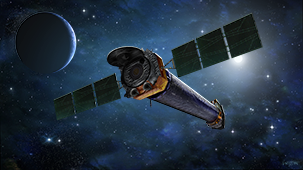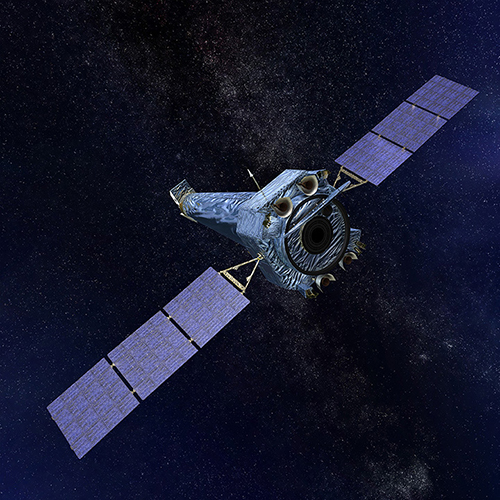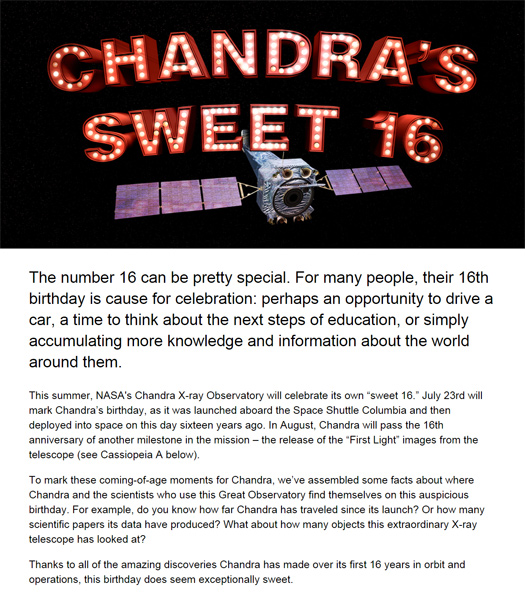Submitted by chandra on Mon, 2019-08-26 09:59
Located about 11,000 light-years from Earth, Cas A (as it's nicknamed) is the glowing debris field left behind after a massive star exploded. When the star ran out of fuel, it collapsed onto itself and blew up as a supernova, possibly briefly becoming one of the brightest objects in the sky. (Although astronomers think that this happened around the year 1680, there are no verifiable historical records to confirm this.)
The shock waves generated by this blast supercharged the stellar wreckage and its environment, making the debris glow brightly in many types of light, particularly X-rays. Shortly after Chandra was launched aboard the Space Shuttle Columbia on July 23, 1999, astronomers directed the observatory to point toward Cas A. It was featured in Chandra's official “First Light” image, released Aug. 26, 1999, and marked a seminal moment not just for the observatory, but for the field of X-ray astronomy. Near the center of the intricate pattern of the expanding debris from the shattered star, the image revealed, for the first time, a dense object called a neutron star that the supernova left behind.
Submitted by chandra on Mon, 2019-07-22 14:20
 Illustration: Chandra X-ray Observatory
Illustration: Chandra X-ray ObservatoryWe make progress in astrophysics in a variety of ways. There is the sort that starts along a defined path, driven by meticulous proposals for telescope time or detailed science justifications for new missions. The plan is to advance knowledge by traveling further than others, or clearing a broader path. And then there are others.
A big mission like NASA's Chandra X-ray Observatory begins with plans for investigation along a slew of different directions and lines of study. At the time of Chandra's launch on July 23rd, 1999, scientists thought these paths would mainly follow studies of galaxy clusters, dark matter, black holes, supernovas, and young stars. Indeed, in the last 20 years we've learned about black holes ripping stars apart (reported eg in 2004, 2011 and 2017), about a black hole generating the deepest known note in the universe, about dark matter being wrenched apart from normal matter in the famous Bullet Cluster and similar objects, about the discovery of the youngest supernova remnant in our galaxy, and much more.
Submitted by chandra on Tue, 2017-08-22 15:03
 Illustration of Chandra X-ray Observatory
Illustration of Chandra X-ray ObservatoryThis week marks the 18th anniversary of Chandra’s “First Light,” when the first publicly available images from NASA’s flagship X-ray mission were released back in 1999 . Week after week, month after month, year after year, Chandra continues to deliver amazing results and make truly extraordinary discoveries across space. Scientists know so much more about the Universe now than we did before this amazing telescope began its work.
Submitted by chandra on Thu, 2015-07-23 10:22

More information at http://chandra.harvard.edu/16th/index.html
Birthdays can be a lot of fun and most teenagers can’t wait to turn sixteen. After all, this birthday often marks new adventures and opportunities (not to mention, maybe a party!)
Today we are celebrating the “sweet 16th” birthday not of a person, but of NASA's Chandra X-ray Observatory. On July 23, 1999, Chandra was launched into space aboard the Space Shuttle Columbia and has been working diligently to explore the high-energy Universe ever since.
Submitted by chandra on Mon, 2012-07-23 13:56
A little bit after midnight (12:31 am EDT to be exact) on July 23, 1999, the Space Shuttle Columbia lifted off from the Kennedy Space Center in Florida. Onboard was what was then the largest payload ever carried by a Shuttle: the Chandra X-ray Observatory.
